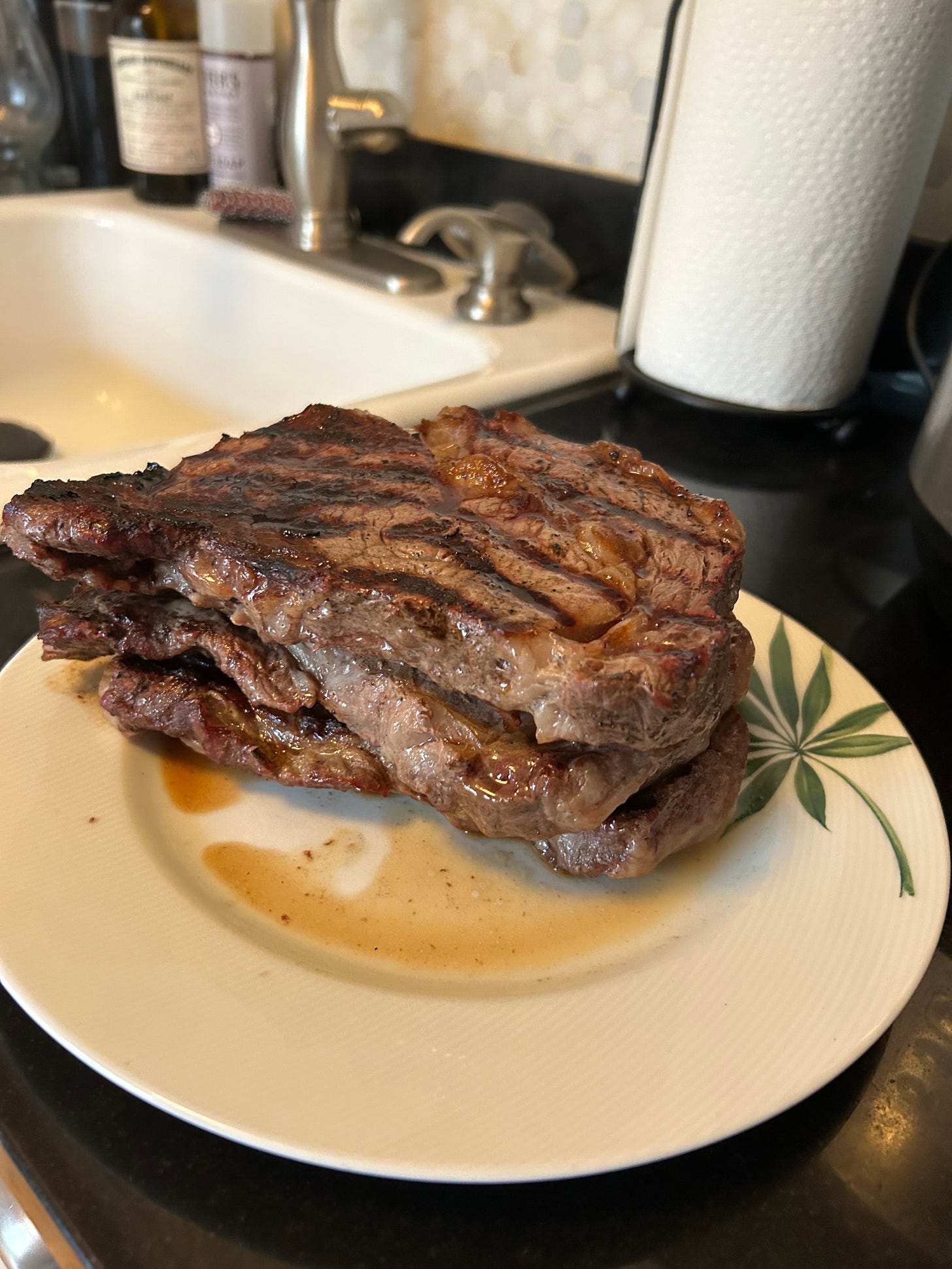beefcakes
The Curious Controversy of Carnivores
The ketogenic diet gets a reputation as a “meat-heavy” way of eating. Probably, this is because most followers are only too happy to share pics on social media of the bacon, steak, and butter that they now consume (relish? revel in?) after having spent a lifetime abstaining from these verboten victuals.
But in fact, it’s very easy to stay in ketosis while eating chicken, broccoli, olive oil, fish, and many of the other foods that enjoy our diet culture’s halo effect. It’s even possible to “go keto” while eating plant-based, vegetarian or even vegan (though you’d better get cozy with olives, avocados and coconuts).
But what about folks who go in the opposite direction? Within the low-carb community, there’s a growing interest in carnivore — that is, eating nothing but animal-based foods. Crazy, right?
I first became aware of the carnivore diet several years ago, when Vinnie Tortorich interviewed Dr. Shawn Baker on his podcast. At the time, Dr. Baker had just recently undertaken a wild experiment — eating nothing but meat and salt for six months. He reported out that not only had he lost weight, but his health markers were all positive, and he’d suffered no vitamin deficiencies. What’s more, he had just set the world record for the 500-meter sprint on the Concept 2 rowing ergometer. At the age of 51.
As a middle-aged rower, myself, my ears perked up at this. But seriously, I thought… nothing but meat? Weird.
Here we are five years later, and Dr. Baker — now 56 — is still eating nothing but meat and still performing athletic feats on Instagram. He has even published a book titled, aptly, The Carnivore Diet. What has changed is that people have begun to take notice.
With a recent article in the New York Times inviting readers to “Meet the Men Who Eat Meat (And Only Meat),” it’s fair to say that carnivory has hit the mainstream, though not in the way it would’ve wanted.
The Times piece is basically a takedown of the diet, describing “meatfluencers” who are seen on TikTok and Instagram “feasting on a petting zoo’s worth of meat products.” It attributes the diet’s popularity to podcasters Joe Rogan, Lex Friedman, and Jordan Peterson, who are dubbed “influential figures in a testosterone-fueled segment of the media often called the ‘manosphere.’”
In this, the NYT follows closely in the footsteps of The New Yorker, who last fall published an article politically titled “Red Shift.” The less-nonsensical subtitle was “Is An All-Meat Diet What Nature Intended?” a question the author then went on to answer with a resounding “no.”
Both articles devote plenty of space to social media influencer, steroid abuser, and all-around buffoon Liver King, and both counterbalance his assertions with those of registered dietitians or academics, which kind of seems like stacking the deck. The Times does interview Dr. Baker, and mentions Dr. Paul Saladino, but omits many other carnivore MDs and PhDs (such as, off the top of my head, anthropologist Bill Schindler and physicians Tony Hampton and Ken Berry — despite even mentioning Berry’s coinage, the B.B.B.E. (Beef, Butter, Bacon and Eggs) diet).
Nor do they mention the original meatfluencer, Vilhjalmur Stefansson. In the 1920s, Stefansson, an arctic explorer, spent lots of time with the Inuit of Alaska. He described how the natives’ cuisine was more advanced than Westerners gave them credit for, and how it was comprised almost entirely meat and fish. He also noted that this plant-less diet left them in excellent health.
Like the carnivores today, Stefansson and his ideas were received with a great deal of skepticism by vegetarian-leaning mainstream Americans. So he set out to prove it. In 1928, Stefansson and a fellow explorer checked into a New York City hospital and, “After a brief control period of a varied diet, the two men ate only fresh meat: The cuts included steak, roast beef, brains, and tongue, with calf liver once a week to ward off scurvy.” The result?
“Doctors examining the two men during the year-long trial reported that neither had heightened blood pressure or kidney trouble, the expected result of a carnivorous diet. The one thing lacking in their diet, Stefansson noted, was enough calcium.”
Stefansson remained a believer long after the experiment ended: “Later in life, he cheerfully returned to a diet of meat and fat, washed down with Martinis. At dinner parties, he sometimes ate nothing but butter with a spoon. He died at the age of 82.”
(On a related note: Al Michaels, renowned sportscaster who, at 78, still looks great and can still call a football game with the best of them, recently admitted that he has “never knowingly eaten a vegetable” in his life.)
But what’s interesting about both the Times and New Yorker articles is that they paint the diet as a largely male, conservative movement, ignoring notable female carnivores like nutritionist Judy Cho (author of The Carnivore Cure), doctors. Georgia Ede, Lisa Wideman, and Rachel Brown, and influencers like “_carnivore_amy,” “steakandbuttergal,” “jessalyn.randle” among others. Far from being a bastion of “toxic masculinity” (and really, is there such a thing as nontoxic masculinity in our current cultural narrative? But that’s a rant for another time…) there’s a growing community of women who have turned to carnivory as an elimination diet, finding that it helps them solve a number of health issues such as autoimmune disorders (In fact, I featured one such story in my book).
What to make of all this? To explore the topic deeper, check out journalist Dr. Nina Teicholz’s excellent article on Substack, which is a much more in-depth and more eloquent look at this phenomenon:
“Journalists have worked themselves into a frenzy of hyperbolic descriptions, which is alarming given that—can we agree?—discussions on food and health should not, as a starting point, be heavily politicized…
“An ancient, authentic association between meat consumption and masculinity has thus been remade for contemporary politics, shoehorned into a culture-war narrative where eating meat is mainly male, usually toxic, and always right-wing. By this accounting, carnivores are not humans who eat meat, eggs, fish, shellfish and sometimes dairy, hoping to cure whatever ails them; Rather, they are beast-like creatures who eat liver, testicles and gnash at raw meat like deranged lunatics.”
There are reasoned and important debates to be had — not just nutritional, but financial, environmental, and more. But turning this diet into a cartoon of itself only shunts aside these larger issues.
Myself, I myself have yet to go all-in. I do eat meat (or fish, or eggs) at pretty much every meal, but I also eat more vegetables than the average person. One of my favorite MAD-appropriate dinners is two roasted chicken thighs (skin on), with 3 cups of steamed broccoli drizzled with olive oil: around 60% fat, 32% protein, 8% carbs. I have trouble swallowing the assertion that veggies are “trying to kill us.” I guess I’m what you’d call carnivore-curious. I could see how winnowing down my carb count close to zero might help me dial in some weight-loss and health, but then I always say, some of my favorite foods are plant-based (coffee, red wine, scotch…).
Then there’s the fact that most Americans today already do eat a plant-based diet, and most are unhealthy. Dr. Peter Ballerstedt points out that 74.6% of our calories come from plants, and most of us (87%) have at least one marker of poor metabolic health. So does it make any sense that “more plants” is the answer?
For lunch just now, I enjoyed some homemade chicken soup — my favorite way of using the leftovers from Anna Vocino’s Roasted Chicken — which included plenty of chopped celery, carrots, onions, garlic and ginger. Without these, it would be a bland soup indeed. And I do think that a lot of the interest around carnivore comes from people’s tendency to seek out the novel, the extreme, the next big thing. It’s like when everyone moved from aerobics to CrossFit, and to paleo, then keto. Now they want to push the envelope further.
Still, I do remain curious.
What say you? Should I follow in Stefansson’s tracks, do a carnivore experiment for maybe a week and report back with the results? Would you join me? We can call it the Carnivore Challenge, if that helps. Who doesn’t love a good Challenge? Lemmeno in the comments below!



Enjoyed your article, and I had already read Nina T’s excellent article on the same subject last week. I have been keto since 2020, and would like to lean more carnivore (or at least ketovore), but it’s very hard! We are really up against it in this society, unfortunately…
If someone wants to take on a carnivore diet, who am I to object? I might consider it for one week but would probably include whole-fat dairy and eggs. My biggest worry with putting plant foods aside is constipation! The Masai in Africa, who are shepherds/cattlemen, are often mentioned as being meat eaters with low rates of cardiac disease. My AI source reports they also drink a lot of milk, including fermented milk, and drink blood which could make up for the calcium problem Stefansson had, and provide a lot of other nutrients that might otherwise be missing. The source also says that they sometimes eat eggs and even plants seasonally.